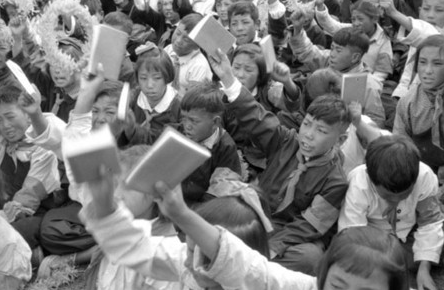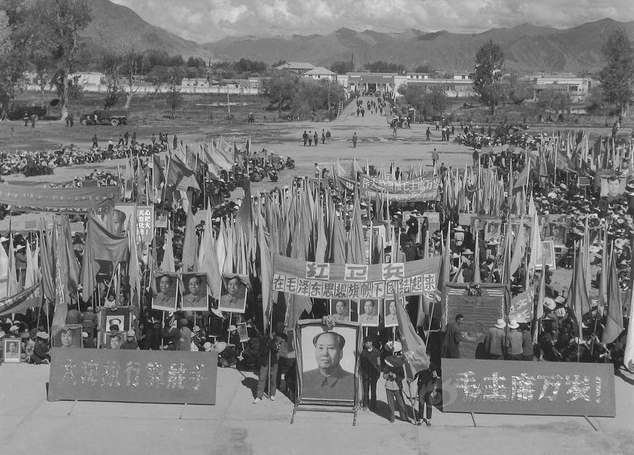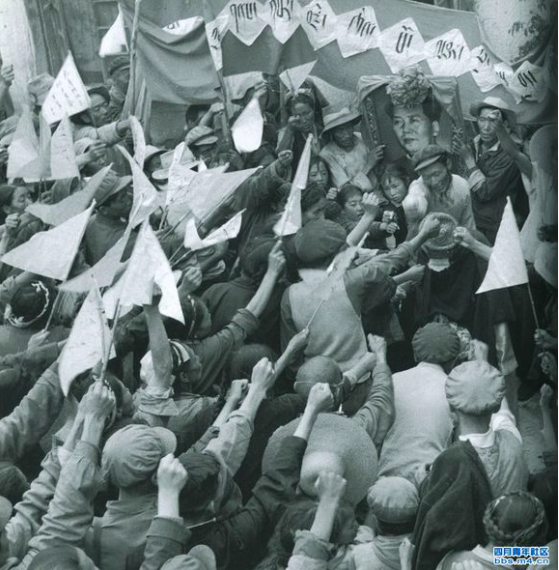This morning I read a great interview with Covell Meyskens, the historian behind the fantastic Everyday Life in Mao’s China, a blog dedicated to photos and paintings of everyday life in China from roughly the 1930s through to the 1980s.
I was struck by the fact that all the images he has obtained have come from the internet. It got me wondering what images I might find across Chinese cyberspace of Tibetan areas during the Mao years and beyond…
Taking Meysken’s project as a source of inspiration, I am hoping to put together a few collections of photographs and images over the next few months, all capturing various events, movements, time periods across the Tibetan plateau.
A quick search through Baidu today turned up several images from the Cultural Revolution, so let’s start there…

A child leads the sloganeering at a public struggle session. Children were frequently used to mobilise the crowds, sometimes against their own parents. This picture was taken by Woeser’s father, a Tibetan People’s Liberation Army’s officer.

On August 18, 1966, three months after Mao’s call for a Cultural Revolution, students from the local college, high schools, and elementary schools marched on the streets of Lhasa. Here they carry a billboard cartoon of the Dalai Lama with a shovel symbolising their determination to bury the “Four Olds” – Old Thoughts, Old Culture, Old Customs and Old Habits.

The burning of many pechas (religious books and scripts) taking place at Sungchorawa, a sacred space adjacent to the Jokhang Temple. The space became not only a major site of incineration, but also, later public struggle sessions.

The front courtyard of the Joking Temple, on August 24, 1966, after the first day of destruction. The Red Guards smashed religious symbols, icons, and artefacts. The Temple’s ground floor hallway was later converted into a pigsty. Notably, the statue of Shakyamuni, said to have been brought by the Chinese Princess Wrenching, was carefully preserved.

The public humiliation of three prominent Tibetans Pomdatsang Topgyal, Tsoekor Dhondup Tsering, and Sambo Tsewang Rinzin (from left to right).

A typical struggle session, organised by a Lhasa neighbourhood committee. Such gatherings were ubiquitous daily events throughout the city in 1966. This one took place in the home of Sangtin Dorje Phagmo, the most prominent female lama in Tibet.

A struggle session against the female ‘Living Buddha’ Sangtin Dorje Phagmo in Lhasa, 1966. (Note: Thank you to Chelsea Hall for the following clarification “In Tibetan tulkus are not considered buddhas, that whole “living buddha” translation is something from Chinese and Japanese Buddhist terminology. They are just referred to as tülkus or reincarnated lamas, not Buddhas)

Sangtin Dorje Phagmo attacked during public humiliation session.

More scenes of struggle sessions.

Public humiliation session.

Public humiliation session in front of Jokhang Temple.

Puren Rinpoche is dragged through the streets of Lhasa. After the end of the Cultural Revolution in 1976, Puren Rinpoche escaped to India.

‘Counter Revolutionary’ during public humiliation session.

Scene from the Nyemu incident when food shortages resulted in locals attacking government and army compounds and rival cadres throughout the region over the course of several weeks in June 1969.

The Nyemu Incident

The Nyemu Incident

The Nyemu Incident

Portrait of Mao on Lixin Avenue, the road leading to Jokhang Temple. Lizin Avenue was formerly known as “Pakuo 帕廓” . Name changing of streets became common practice during the Cultural Revolution.

Tibetan children hold up their Little Red Books.
Pan Chashao: A short story book produced in 1973 about a Tibetan woman’s role in border patrol.

Outside Jokhang Temple, Lhasa’s Red Guards carry out first ‘Revolutionary Activity’ (革命行动) (August, 1966)

The “Educated Youth” (zhiqing) arrive in Lhasa during the early 1970s. The “Educated Youth” were the young people who left China’s urban districts (some voluntarily, some by force) during the 1950s until the end of the Cultural Revolution to live and work in rural areas as part of the “Up to the Mountains, Down to the Countryside” (shangshanxiaxiang) movement.

50,000 people gather in Lhasa to celebrate the 17th anniversary of the establishment of the People’s Republic of China.

The Red Guards gather with portraits of Mao

Gathering outside Potala Palace, Lhasa

No details

No details

No details

No details

No details
For anyone looking for more information on the Cultural Revolution in Tibet, I highly recommend:
Melvyn Goldstein, Ben Jiao and Tanzen Lhundrup’s On the Cultural Revolution in Tibet: The Nyemo Incident of 1969
Tsering Woeser’s Forbidden Memory: Tibet During the Cultural Revolution



Hello. I loved seeing your new blog of photos of China and Tibet from 1960s forward. These will certainly add more substance to the on-going exposure of this tragic time period in Tibetan history. I particularly found the image by Woeser’s father very interesting. Mostly because it added a piece of info to me about her: that she is 2nd gen of indigenous Tibetan chroniclers. I noticed that the caption to the 3rd image says peaches burning. I think it’s meant to be Pechas, as you say they are religious documents. You probably know that Pechas are the horizontal prayer “books” of individual leaves of paper with the Tibetan prayers written on both sides that are easily read through during recitation and study. In any event, I too am interested to see what more you further excavate from the public domain of the Internet of that blighted era that unfortunately continues today. I must say that some of the pics are hard to look at. Not because they are gruesome but because they make the history more real, more visual, thereby eliciting a more visceral response. Thank you for all of the great work you do.
LikeLike
Thanks for this. It’s easy to brush over words and statistics but a picture is much more arresting.
LikeLike
[…] In Tibet and the Cultural Revolution, I compiled a series of images capturing events from the most turbulent period of history in modern Tibet. One of the images that you might remember from the collection was Pan Chashao (1973), an illustrated story book (lianhuanhua/连环画) about a Tibetan woman’s role in border patrol. […]
LikeLike